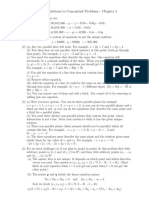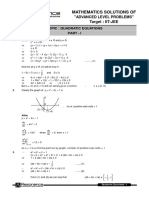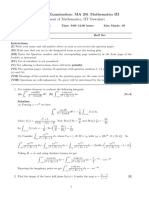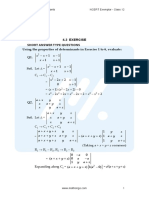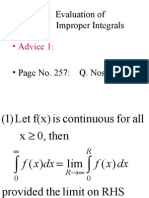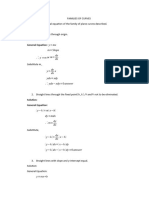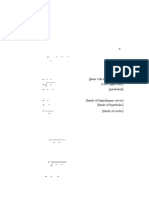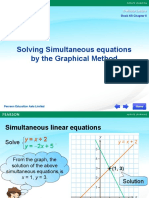Math241 Tutorial 5
Uploaded by
Maaz qureshi 1Math241 Tutorial 5
Uploaded by
Maaz qureshi 1MATH 241 Linear Algebra and Ordinary Differential Equations
TUTORIAL
Question 1: Determine span {v1 , v 2 } for the given vectors in R3 .
a) v 1=( 1 ,−1 ,2 ) , v 2 =( 2,−1 ,3 )
3
Solution: Let’s say where v=(x , y , z ) any vector in R , x , y , z ∈ R
c 1 . v 1+ c 2 . v 2=v
c 1 . ( 1 ,−1 , 2 ) +c 2 . ( 2 ,−1 , 3 )=( x , y , z)
The 3x2 linear system of equations;
c 1 +2 c 2=x
-c 1−c 2= y
2c 1 +3 c 2=z
We solve above system,
R1 + R2 → R2
( ) ( )
1 2 ⋮ x 1 2 ⋮ x
−1 −1 ⋮ y −2 R 1+ R 3 → R3 0 1 ⋮ x+ y
2 3 ⋮ z → 0 −1 ⋮ z−2 x
¿
( )
¿ R2 + R3 → R 3 1 2 ⋮ x
→ 0 1 ⋮ x+ y
¿ 0 0 ⋮ z+ y −x
If z + y−x ≠ 0, there is no solution. So we can not find any scalar c 1 , c2 ∈ R .
For solution, z + y−x=0 must be satisfied. Here we get x=z + y . The vector v becomes,
v=( x , y , z )=(z + y , y , z )
So; the vectors v 1=( 1 ,−1 ,2 ) , v 2 =( 2,−1 ,3 ) span the subspace of
span { v 1 , v 2 }={v =( z+ y , y , z ) : z , y ∈ R } is a subspace of
EMU, Math 241 Linear Algebra and Ordinary Differential Equations 1
b) v 1=( 1 ,2 ,−1 ) , v 2 =(−2 ,−4 , 2 )
Solution:
Let’s say c 1 . v 1+ c 2 . v 2=v where v=(x , y , z ) any vector in R3 .
c 1 . v 1+ c 2 . v 2=v
c 1 . ( 1 , 2 ,−1 ) +c 2 . (−2 ,−4 , 2 )=( x , y , z)
The 3x2 system of linear equations;
c 1 +2 c 2=x
2c 1−4 c 2= y
−c 1 +2 c 2=z
We solve above system,
−2 R 1+ R 2 → R2
R 1+ R 3 → R3
( )(
1 −2 ⋮ x ¿
)
2 −4 ⋮ y 1 −2 ⋮ x
−1 2 ⋮ z ¿ 0 0 ⋮ y −2 x
0 0 ⋮ z+x
¿
If y−2 x ≠0 , or z + x ≠ 0, there is no solution. So we can not find any scalar c 1 , c2 ∈ R .
For solution, y−2 x=0 and z + x=0 must be satisfied.
Here we get, y=2 x and z=−x . The vector v becomes,
v=( x , y , z )=(x , 2 x ,−x )
So; v 1=( 1 ,2 ,−1 ) , v 2 =(−2 ,−4 , 2 ) span the subspace of R3
span { v 1 , v 2 }={v =( x , 2 x ,−x ) : x ∈ R is a subspace of . The subspace is the line with
Parametric equations through the origin in
EMU, Math 241 Linear Algebra and Ordinary Differential Equations 2
Question 2: Let W be the subspace of R3 spanned by the vectors v 1=( 1 ,1 ,−1 ) ,
v 2=( 2 ,1 , 3 ) , and v 3=(−2 ,−2 , 2 ).
Show that W is also spanned by v 1 and v 2 only.
Solution: Let’s find the subspace S which is spanned by v 1 , v 2 and v 3 .
c 1 . v 1+ c 2 . v 2 +c 3 . v 3=v
c 1 . ( 1 , 1 ,−1 ) +c 2 . ( 2 , 1, 3 ) + c3 . (−2 ,−2 , 2 )=(x , y , z )
The system of equations;
c 1 +2 c 2−2 c3 =x
c 1 +c 2−2 c 3= y
−c 1 +3 c 2+ 2 c3=z
We solve above system,
−R 1+ R 2 → R2
( ) ( )
1 2 −2 ⋮ x 1 2 −2 ⋮ x
1 1 −2 ⋮ y R 1+ R 3 → R3 0 −1 0 ⋮ y −x
−1 3 2 ⋮ z → 0 5 0 ⋮ z+ x
¿
( )
¿−R2 → R 2 1 2 −2 ⋮ x
→ 0 1 0 ⋮ x− y
¿ 0 5 0 ⋮ z+x
( )
¿−5 R2 + R3 → R3 1 2 −2 ⋮ x
→ 0 1 0 ⋮ x− y
¿ 0 0 0 ⋮ z−4 x+ 5 y
EMU, Math 241 Linear Algebra and Ordinary Differential Equations 3
For solution, z−4 x+ 5 y=0 must be satisfied. And, we get, z=4 x−5 y .
So;
S={v =( x , y ,−4 x +5 y ) : x , y ∈ R }
is the subspace which is spanned by v 1 , v 2 and v 3 .
Now, we have to show that, span {v1 , v 2 }=S .
c 1 . v 1+ c 2 . v 2=v
c 1 . ( 1 , 1 ,−1 ) +c 2 . ( 2 , 1, 3 ) =(x , y , z)
The system of equations;
c 1 +2 c 2=x
c 1 +c 2= y
−c 1 +3 c 2=z
We solve above system,
−R1 + R2 → R 2
( ) ( )
1 2 ⋮ x 1 2 ⋮ x
1 1 ⋮ y R1 + R3 → R3 0 −1 ⋮ y −x
−1 3 ⋮ z → 0 5 ⋮ z+x
¿
( )
¿−R2 → R 2 1 2 ⋮ x
→ 0 1 ⋮ x− y
¿ 0 5 ⋮ z+ x
( )
¿−5 R2 + R3 → R3 1 2 ⋮ x
→ 0 1 ⋮ x− y
¿ 0 0 ⋮ z −4 x +5 y
Here, we get the same result. For solution, the equation z−4 x+ 5 y=0 must be satisfied. Then,
we can write z=4 x−5 y . Hence the vector v=(x , y , z ) becomes v=(x , y , 4 x−5 y )
So;
S={v =( x , y ,−4 x +5 y ) : x , y ∈ R } is the subspace which is also spanned by v 1 and v 2 .
EMU, Math 241 Linear Algebra and Ordinary Differential Equations 4
Question 3: Determine whether the given vector v lies in span { v 1 , v 2 } .
a) v=(3 , 3 , 4) , v 1=( 1 ,−1 ,2 ) , v 2 =( 2, 1 , 3 ) in R3
Solution:
v=(3 , 3 , 4) , v 1=( 1 ,−1 ,2 ) , v 2 =( 2, 1 , 3 )
c 1 . v 1+ c 2 . v 2=v
c 1 . ( 1 ,−1 , 2 ) +c 2 . ( 2 , 1 ,3 )=(3 , 3 , 4)
The 3x2 system of linear equations;
c 1 +2 c 2=3
−c 1 +c 2=3
2 c 1+ 3 c2 =4
We solve above system;
R1 + R2 → R2
( ) ( )
1 2 ⋮ 3 1 2 ⋮ 3
−1 1 ⋮ 3 −2 R 1 + R 3 → R 3 0 3 ⋮ 6
2 3 ⋮ 4 → 0 −1 ⋮ −2
¿
( )
¿ R → R2 1 2 ⋮ 3
3 2 0 1 ⋮ 2
→ 0 −1 ⋮ −2
¿
( )
¿ R2 + R3 → R 3 1 2 ⋮ 3
→ 0 1 ⋮ 2
¿ 0 0 ⋮ 0
c 1 +2 c 2=3 and c 2=2
It is easy to find that c 1=−1 by using above equalities.
Then, we can write the vector v as : v=−1 v 1 +2 v 2
So, v lies in span { v 1 , v 2 }.
b ¿ v=(5 ,3 ,−6), v 1=(−1 ,1 , 2 ) , v 2=( 3 , 1,−4 ) in R3
EMU, Math 241 Linear Algebra and Ordinary Differential Equations 5
Solution:
v=(5 , 3 ,−6), v 1=(−1 ,1 , 2 ) , v 2=( 3 , 1,−4 )
c 1 . v 1+ c 2 . v 2=v
c 1 . (−1 , 1 ,2 ) + c2 . ( 3 ,1 ,−4 )=(5 , 3 ,−6)
The system of equations;
−c 1 +3 c 2=5
c 1 +c 2=3
2 c 1−4 c 2=−6
We solve above system;
R 1+ R 2 → R 2
( ) ( )
−1 3 ⋮ 5 −1 3 ⋮ 5
1 1 ⋮ 3 −2 R 1 + R 3 → R 3 0 4 ⋮ 8
2 −4 ⋮ −6 → 0 −10 ⋮ −16
¿
( )
¿ R → R2 −1 3 ⋮ 5
4 2 0 1 ⋮ 2
→ 0 −10 ⋮ −16
¿
( )
¿ 10 R2 + R3 → R3 −1 3 ⋮ 5
→ 0 1 ⋮ 2
¿ 0 0 ⋮ 0
−c 1 +3 c 2=5
c 2=2
It is easy to find that c 1=1 by using above equalities.
Then, we can write the vector v as : v=1 v 1 +2 v 2
So, v lies in span { v 1 , v 2 }.
EMU, Math 241 Linear Algebra and Ordinary Differential Equations 6
Question 4: Determine whether the given set of vectors are linearly independent or linearly
dependent in Rn . In the case of linearly dependence, find a dependency relationship.
a) { (1 ,−1 ) , (1, 1)}
Solution: The vectors v 1=( 1 ,−1 ) , v 2=( 1 ,1 ) are in R2
For linearly independent,
c 1 . v 1+ c 2 . v 2=0 if and only if when c 1=c 2=0.
Otherwise it is linearly dependent.
c 1 . v 1+ c 2 . v 2=0
c 1 . ( 1 ,−1 )+ c2 . ( 1, 1 )=(0 , 0)
The system of equations;
c 1 +c 2=0
−c 1 +c 2=0
We solve above system;
¿ R 1+ R 2 → R2
¿
( 1 1 ⋮ 0
−1 1 ⋮ 0 ¿
1 1 ⋮ 0
0 2 ⋮ 0
)( )
¿
c 1 +c 2=0
2 c 2=0
Here we get, c 2=0 and c 1=0 , which implies that the system has only trivial solution c 1 ¿ c2 =0 .
Hence, { (1 ,−1 ) , (1, 1)} are linearly independent in R2
EMU, Math 241 Linear Algebra and Ordinary Differential Equations 7
b) { (2 ,−1 ) , ( 3 , 2 ) ,(0 , 1)}
Solution: ( 2 ,−1 ) , ( 3 , 2 ) ,(0 ,1) vectors are in R2 .We have 3 vectors in R2 and dimension of R2 is
2. So, the number of vectors is greater than dimension of the space.
Hence ( 2 ,−1 ) , ( 3 , 2 ) ,(0 ,1) are linearly dependent in R2.
EMU, Math 241 Linear Algebra and Ordinary Differential Equations 8
c) { (1 ,−1, 0 ) , ( 0 , 1 ,−1 ) ,(1 ,1 , 1)}
Solution: ( 1 ,−1 , 0 ) , ( 0 ,1 ,−1 ) , (1, 1 , 1) are in R3.
For linearly independent,
c 1 . v 1+ c 2 . v 2 +c 3 . v 3=0 if and only if when c 1=c 2=c3 =0.
Otherwise it is linearly dependent.
c 1 . v 1+ c 2 . v 2 +c 3 . v 3=0
c 1 . ( 1 ,−1 , 0 ) + c2 . ( 0 ,1 ,−1 )+ c 3 .(1 , 1 ,1)=(0 , 0 , 0)
The system of equations;
c 1 +c 3=0
−c 1 +c 2 +c 3=0
−c 2 +c 3=0
We solve above system;
( ) ( )
1 0 1 ⋮ 0 ¿ R 1+ R 2 → R 2 1 0 1 ⋮ 0
−1 1 1 ⋮ 0 → 0 1 2 ⋮ 0
0 −1 1 ⋮ 0 ¿ 0 −1 1 ⋮ 0
( )
¿ R2 + R3 → R 3 1 0 1 ⋮ 0
→ 0 1 2 ⋮ 0
¿ 0 0 3 ⋮ 0
c 1 +c 3=0
c 2 +2 c 3=0
3 c 3=0
Here we get, c 1=0 , c 2=0 and c 3=0 , which implies that the system has only trivial solution
c 1 ¿ c2 =c 3=0 . Hence, { (1 ,−1, 0 ) , ( 0 , 1 ,−1 ) ,(1 ,1 , 1)} are linearly independent in R3.
d) { (1 , 2 ,3 ) , ( 1 ,−1 , 2 ) ,(1 ,−4 , 1)}
EMU, Math 241 Linear Algebra and Ordinary Differential Equations 9
Solution: ( 1 , 2, 3 ) , ( 1 ,−1 ,2 ) ,(1 ,−4 ,1) are in R3.
For linearly independent,
c 1 . v 1+ c 2 . v 2 +c 3 . v 3=0 if and only if when c 1=c 2=c3 =0.
Otherwise it is linearly dependent.
c 1 . v 1+ c 2 . v 2 +c 3 . v 3=0
c 1 . ( 1 , 2 ,3 )+ c2 . ( 1,−1 ,2 )+ c3 .(1 ,−4 , 1)=(0 ,0 , 0)
The system of equations;
c 1 +c 2+ c 3=0
2 c 1−c 2−4 c 3=0
3 c 1+ 2 c2 +c 3=0
We solve above system;
−2 R1 + R2 → R2
( ) ( )
1 1 1 ⋮ 0 1 1 1 ⋮ 0
2 −1 −4 ⋮ 0 −3 R1 + R3 → R3 0 −3 −6 ⋮ 0
3 2 1 ⋮ 0 → 0 −1 −2 ⋮ 0
¿
−1
( )
¿ R → R2 1 1 1 ⋮ 0
3 2 0 1 2 ⋮ 0
→ 0 −1 −2 ⋮ 0
¿
( )
¿ R2 + R3 → R 3 1 1 1 ⋮ 0
→ 0 1 2 ⋮ 0
¿ 0 0 0 ⋮ 0
So, c 3=t when t ∈ R.
c 1 +c 2+ c 3=0
c 2 +2 c 3=0
c 3=t
Hence, c 3=t , c 2=−2t and c 1=t .
That means we have infinitely many solutions which is satisfying the equation
c 1 v 1 +c 2 v 2+ c 3 v 3=0.
EMU, Math 241 Linear Algebra and Ordinary Differential Equations 10
So, the vectors are linearly dependent.
Taking t=1 000, and substituting these values for c 1 , c2 , c 3 into the next equation.
c 1 . v 1+ c 2 . v 2 +c 3 . v 3=0
We have,
1 v 1−2 v 2 +1 v 3 =0
Or equivalently,
v 1=2 v 2−v 3
Which can be easily verified using the given expression v 1 , v 2 and v 3 .
It follows that;
span { v 2 , v 3 }=span { v 1 , v 2 , v 3 }
Hence, { (1 , 2 ,3 ) , ( 1 ,−1 , 2 ) ,(1 ,−4 , 1)} are linearly dependent in R3.
EMU, Math 241 Linear Algebra and Ordinary Differential Equations 11
e) { (1 ,−1, 2 , 3 ) , ( 2 ,−1, 1 ,−1 ) ,(−1 , 1 ,1 , 1) }
Solution: ( 1 ,−1 , 2 ,3 ) , ( 2 ,−1 , 1 ,−1 ) ,(−1 ,1 , 1 ,1) are in R4 .
For linearly independent,
c 1 v 1 +c 2 v 2+ c 3 v 3=0 if and only if when c 1=c 2=c3 =0.
Otherwise it is linearly dependent.
c 1 . v 1+ c 2 . v 2 +c 3 . v 3=0
c 1 . ( 1 ,−1 , 2 ,3 )+ c 2 . ( 2 ,−1 , 1,−1 ) +c 3 . (−1 ,1 , 1, 1)=(0 , 0 ,0 , 0)
The system of equations;
c 1 +2 c 2−c 3=0
−c 1−c2 +c 3=0
2 c 1+ c 2+ c3 =0
3 c 1−c 2 +c 3=0
We solve above system;
R1 + R2 → R2
−2 R1 + R3 → R3
→
( )(
1 2 −1 ⋮ 0
−3 R 1+ R 4 → R 4
−1 −1 1 ⋮ 0
)
2 1 1 ⋮ 0 1 2 −1 ⋮ 0
3 −1 1 ⋮ 0 ¿ 0 1 0 ⋮ 0
0 −3 3 ⋮ 0
0 −7 4 ⋮ 0
¿
( ) ( )
3 R 2+ R 3 → R3 1 2 −1 ⋮ 0 1 1 2 −1 ⋮ 0
0 1 0 ⋮ 0 ¿ R3 → R3 0 1 0 ⋮ 0
7 R2 + R4 → R4 3
→ 0 0 3 ⋮ 0 → 0 0 1 ⋮ 0
¿ 0 0 4 ⋮ 0 ¿ 0 0 4 ⋮ 0
( )
1 2 −1 ⋮ 0
¿−4 R3 + R4 → R 4 0 1 0 ⋮ 0
→ 0 0 1 ⋮ 0
¿
0 0 0 ⋮ 0
c 1 +2 c 2−c 3=0 , c 2=0 , c 3=0 .
Here we get, c 1=0 , c 2=0 and c 3=0 , which implies that the system has only trivial solution
EMU, Math 241 Linear Algebra and Ordinary Differential Equations 12
c 1 ¿ c2 =c 3=0 . Hence, { (1 ,−1, 2 , 3 ) , ( 2 ,−1, 1 ,−1 ) ,(−1 , 1 ,1 , 1) are linearly independent in R4 .
EMU, Math 241 Linear Algebra and Ordinary Differential Equations 13
f) { (2 ,−1 ,0 , 1 ) , (1 , 0 ,−1 , 2 ) , ( 0 ,3 , 1 , 2 ) ,(−1 ,1 , 2 ,1)}
Solution: ( 2 ,−1 , 0 , 1 ) , ( 1 , 0 ,−1 , 2 ) , ( 0 , 3 , 1, 2 ) ,(−1 , 1 ,2 , 1) are in R4 .
For linearly independent,
c 1 . v 1+ c 2 . v 2 +c 3. v 3 +c 4 . v 4=0 if and only if when c 1=c 2=c3 =c 4=0.
Otherwise it is linearly dependent.
c 1 . v 1+ c 2 . v 2 +c 3 . v 3+ c 4 . v 4 =0
c 1 . ( 2 ,−1 , 0 , 1 ) +c 2 . ( 1 , 0 ,−1 , 2 )+ c 3 . ( 0 , 3 ,1 , 2 ) +c 4 .(−1 , 1 ,2 , 1)=(0 , 0 , 0 , 0)
The system of equations;
2 c 1+1 c 2−c 4=0
−c 1 +3 c 3+ c 4=0
−c 2 +c 3 +2 c 4=0
c 1 +2 c 2+2 c 3 +c 4 =0
We solve above system;
( ) ( )
2 1 0 −1 ⋮ 0 1 2 2 1 ⋮ 0
−1 0 3 1 ⋮ 0 ¿ R 1 ↔ R 4 −1 0 3 1 ⋮ 0
0 −1 1 2 ⋮ 0 → 0 −1 1 2 ⋮ 0
¿
1 2 2 1 ⋮ 0 2 1 0 −1 ⋮ 0
( )
R 1+ R 2 → R 2 1 2 2 1 ⋮ 0
−2 R1 + R4 → R 4 0 2 5 2 ⋮ 0
→ 0 −1 1 2 ⋮ 0
¿ 0 −3 −4 −3 ⋮ 0
( )
1 2 2 1 ⋮ 0
¿ R2 ↔ R3 0 −1 1 2 ⋮ 0
→ 0 2 5 2 ⋮ 0
¿
0 −3 −4 −3 ⋮ 0
( )
1 2 2 1 ⋮ 0
¿−R2 → R2 0 1 −1 −2 ⋮ 0
→ 0 2 5 2 ⋮ 0
¿
0 −3 −4 −3 ⋮ 0
EMU, Math 241 Linear Algebra and Ordinary Differential Equations 14
( )
−2 R2 + R3 → R3 1 2 2 1 ⋮ 0
3 R 2+ R 4 → R 4 0 1 −1 −2 ⋮ 0
→ 0 0 7 6 ⋮ 0
¿ 0 0 −7 −6 ⋮ 0
( )
1 2 2 1 ⋮ 0
¿ R3 + R 4 → R4 0 1 −1 −2 ⋮ 0
→ 0 0 7 6 ⋮ 0
¿
0 0 0 0 ⋮ 0
( )
1 2 2 1 ⋮ 0
1
¿ R + R 4 → R4 0 1 −1 −2 ⋮ 0
7 3 6
→ 0 0 1 ⋮ 0
7
¿
0 0 0 0 ⋮ 0
So, c 4 =t when t ∈ R.
c 1 +2 c 2+2 c 3 +c 4 =0
c 2−c3−2 c 4=0
6 −11 8 −6
c 3 + c 4 =0 Hence, c 1= t , c 2= t ,c 3= t and c 4 =t .
7 7 7 7
That means we have infinitely many solutions which is satisfying the equation
c 1 v 1 +c 2 v 2+ c 3 v 3+ c 4 v 4 =0.
So, the vectors are linearly dependent.
Taking t=1, and substituting these values for c 1 , c2 , c 3 , c 4 into the above equation.We have,
−11 8 6
v + v 2− v 3 + v 4=0
7 1 7 7
Or equivalently,
11 8 6
v 4= v− v+ v
7 1 7 2 7 3
Which can be easily verified using the given expression v 1 , v 2 , v 3 and v 4 .
It follows that;
span { v 1 , v 2 , v 3 }=span { v 1 , v 2 , v 3 , v 4 }
EMU, Math 241 Linear Algebra and Ordinary Differential Equations 15
Hence, { (2 ,−1 ,0 , 1 ) , (1 , 0 ,−1 , 2 ) , ( 0 ,3 , 1 , 2 ) , (−1 , 1, 2 , 1 ) } are linearly dependent in R4 .
Question 5: Determine all values of the constant k for which the given set of vectors is
linearly independent in R4 .
{ (1 , 0 , 1 ,k ) , (−1 , 0 , k ,1 ) ,(2, 0 , 1 ,3) }
Solution: ( 1 , 0 ,1 , k ) , (−1 ,0 ,k , 1 ) ,(2 , 0 ,1 , 3) are in R4 .
For linearly independent,
c 1 . v 1+ c 2 . v 2 +c 3 . v 3=0 if and only if when c 1=c 2=c3 =0.
Otherwise it is linearly dependent.
c 1 . v 1+ c 2 . v 2 +c 3 . v 3=0
c 1 . ( 1 , 0 ,1 , k )+ c 2 . (−1 ,0 , k , 1 ) +c 3 .(2 , 0 ,1 , 3)=(0 ,0 , 0 , 0)
The system of equations;
c 1−c 2 +2 c 3=0
c 1 +k c 2 +c 3=0
k c 1 +c 2 +3 c 3=0
We solve above system;
−R 1+ R 2 → R2
( ) ( )
1 −1 2 ⋮ 0 1 −1 2 ⋮ 0
1 k 1 ⋮ 0 −kR1 + R3 → R3 0 k +1 −1 ⋮ 0
k 1 3 ⋮ 0 → 0 k +1 3−2 k ⋮ 0
¿
( )
¿−R2 + R3 → R 3 1 −1 2 ⋮ 0
→ 0 k +1 −1 ⋮ 0
¿ 0 0 4−2 k ⋮ 0
For a trivial solution (c 1=c 2=c3 =0) ; the equations
4−2 k ≠ 0 and k +1 ≠ 0 k ≠ 2 and k ≠−1
Must be satisfied. Otherwise, we can find infinitely many solutions and it makes our vectors
linearly dependent.
EMU, Math 241 Linear Algebra and Ordinary Differential Equations 16
Hence, ( 1 , 0 ,1 , k ) , (−1 ,0 ,k , 1 ) ,(2 , 0 ,1 , 3)} are linearly independent in R4 when k ∈ R ¿−1 , 2}.
Question 6: Determine whether the given set of vectors are linearly independent in M 2 (R)
A 1= (10 11) , A =(20
2
−1
1 )
, A3 =
3 6
0 4
. ( )
Solution:
For linearly independent,
c 1 A 1+ c 2 A2 +c 3 A 3=0 if and only if when c 1=c 2=c3 =0.
Otherwise it is linearly dependent.
c 1 . A 1+ c2 . A 2+ c 3 . A3=0
c1 . (10 11)+ c .(20
2
−1
1 ) ( )( )
+ c3.
3 6
0 4
=
0 0
0 0
The system of equations;
c 1 +2 c 2+3 c 3=0
c 1−c 2 +6 c 3=0
c 1 +c 2+ 4 c3 =0
We solve above system;
−R1+ R2 → R2
( ) ( )
1 2 3 ⋮ 0 1 2 3 ⋮ 0
1 −1 6 ⋮ 0 −R 1 + R 3 → R 3 0 −3 3 ⋮ 0
1 1 4 ⋮ 0 → 0 −1 1 ⋮ 0
¿
−1
( )
¿ R → R2 1 2 3 ⋮ 0
3 2 0 1 −1 ⋮ 0
→ 0 −1 1 ⋮ 0
¿
( )
¿ R2 + R3 → R 3 1 2 3 ⋮ 0
→ 0 1 −1 ⋮ 0
¿ 0 0 0 ⋮ 0
So, c 3=t when t ∈ R.
c 1 +2 c 2+3 c 3=0
c 2−c3=0
EMU, Math 241 Linear Algebra and Ordinary Differential Equations 17
c 3=t
Hence, c 3=t , c 2=t and c 1=−5 t .
That means we have infinitely many solutions which is satisfying the equation
c 1 . A 1+ c2 . A 2+ c 3 . A3=0.
So, the vectors are linearly dependent.
[t=1; −5. A 1 +1. A 2+1 . A 3=0 ]
EMU, Math 241 Linear Algebra and Ordinary Differential Equations 18
Question 7: Determine whether the given set of vectors is linearly independent in P1
p1 ( x ) =1−x , p2 ( x ) =1+ x
Solution: p1 ( x ) , p 2 ( x ) are in P1 .
For linearly independent,
c 1. p1 ( x ) +c 2 . p2 ( x )=0 if and only if when c 1=c 2=0.
Otherwise it is linearly dependent.
c 1 . p1 ( x )+ c 2 . p 2 ( x )=0
c 1 . ( 1−x ) + c2 . ( 1+ x ) =0+0 x
The system of equations;
c 1 +c 2=0
−c 1 +c 2=0
We solve above system;
¿ R1 + R2 → R2
( 1 1 ⋮ 0
−1 1 ⋮ 0 ) →
¿
(
1 1 ⋮ 0
0 2 ⋮ 0 )
c 1 +c 2=0
2 c 2=0
Here we get, c 2=0 and c 1=0 , which implies that the system has only trivial solution c 1 ¿ c2 =0 .
Hence, { p1 ( x ) , p2 ( x ) } are linearly independent in P1.
Polynomials : a x 0 +b x 1+ c x 2 +d x3 ∈ P3
EMU, Math 241 Linear Algebra and Ordinary Differential Equations 19
You might also like
- Mind Action Series Igrade 11 Paper 2 MemorandumNo ratings yetMind Action Series Igrade 11 Paper 2 Memorandum10 pages
- Systems of Differential Equations: 1 ExercicesNo ratings yetSystems of Differential Equations: 1 Exercices8 pages
- Math 308 Solutions To Conceptual Problems - Chapter 1No ratings yetMath 308 Solutions To Conceptual Problems - Chapter 13 pages
- Past EDME3203 Final Examination SolutionsNo ratings yetPast EDME3203 Final Examination Solutions10 pages
- ALP Solutions Quadratic Equation Maths EngNo ratings yetALP Solutions Quadratic Equation Maths Eng9 pages
- Ans-Sol JEEMain-2022 Phase-2 29-07-2022 E MathsNo ratings yetAns-Sol JEEMain-2022 Phase-2 29-07-2022 E Maths9 pages
- Complex Integration: Line Integral of A Complex FunctionNo ratings yetComplex Integration: Line Integral of A Complex Function8 pages
- Ncert Exemplar Math Class 12 Chapter 04 DeterminantsNo ratings yetNcert Exemplar Math Class 12 Chapter 04 Determinants38 pages
- 2022 Mathematical Methods Trial Exam 1 Solutions 1No ratings yet2022 Mathematical Methods Trial Exam 1 Solutions 12 pages
- Cambridge Methods 3&4 - Chapter 3 - Transformations - SolutionsNo ratings yetCambridge Methods 3&4 - Chapter 3 - Transformations - Solutions44 pages
- Exact Differential Equations Solutions (Alternate Method)No ratings yetExact Differential Equations Solutions (Alternate Method)3 pages
- R = ( (x,y) 0 ≤ x ≤ π: Topic: Double integralsNo ratings yetR = ( (x,y) 0 ≤ x ≤ π: Topic: Double integrals7 pages
- Original Problem Series Week-2: WWM MathsNo ratings yetOriginal Problem Series Week-2: WWM Maths8 pages
- Eew - ps2 - Sol (Functions and Equations)No ratings yetEew - ps2 - Sol (Functions and Equations)6 pages
- Ma201 Mathematics - Iii, Quiz II : Model Solutions and Marking SchemeNo ratings yetMa201 Mathematics - Iii, Quiz II : Model Solutions and Marking Scheme5 pages
- Ncert Exemplar Math Class 12 Chapter 04 DeterminantsNo ratings yetNcert Exemplar Math Class 12 Chapter 04 Determinants38 pages
- 12th Maths Unit 1 Solutions English MediumNo ratings yet12th Maths Unit 1 Solutions English Medium26 pages
- Solving Simultaneous Equations by The Graphical Method: Book 4B Chapter 8No ratings yetSolving Simultaneous Equations by The Graphical Method: Book 4B Chapter 815 pages
- Limits Practice - Pre-Calculus: Semester Two ReviewNo ratings yetLimits Practice - Pre-Calculus: Semester Two Review3 pages
- Mathematics: Quarter 2, Module 3 Solving Problems Involving Quadratic Equations and Rational Algebraic EquationsNo ratings yetMathematics: Quarter 2, Module 3 Solving Problems Involving Quadratic Equations and Rational Algebraic Equations28 pages
- Riemann-Stieltjes Integrals with α a Step Function: t→s t>s t→s t<sNo ratings yetRiemann-Stieltjes Integrals with α a Step Function: t→s t>s t→s t<s2 pages
- (Translations of Mathematical Monographs) A. N. Andrianov and v. G. Zhuravlev - Modular Forms and Hecke Operators (1995, American Mathematical Society)No ratings yet(Translations of Mathematical Monographs) A. N. Andrianov and v. G. Zhuravlev - Modular Forms and Hecke Operators (1995, American Mathematical Society)347 pages
- Amou, Bugeaud. Mahler's Classification of Complex NumbersNo ratings yetAmou, Bugeaud. Mahler's Classification of Complex Numbers16 pages
- Consider The Bases B (U1, U2, U3) and B' (U'1, U'2, U'3) - QuizletNo ratings yetConsider The Bases B (U1, U2, U3) and B' (U'1, U'2, U'3) - Quizlet8 pages
- On the free vibration responseof rectangular plates, partially supported on elastic foundationNo ratings yetOn the free vibration responseof rectangular plates, partially supported on elastic foundation10 pages
- Math 5285H: Fundamental Structures of Algebra I: Take Home Exam 1, (Due in Class, October 12th, 2011)No ratings yetMath 5285H: Fundamental Structures of Algebra I: Take Home Exam 1, (Due in Class, October 12th, 2011)2 pages
- Math 308 Solutions To Conceptual Problems - Chapter 1Math 308 Solutions To Conceptual Problems - Chapter 1
- Complex Integration: Line Integral of A Complex FunctionComplex Integration: Line Integral of A Complex Function
- Ncert Exemplar Math Class 12 Chapter 04 DeterminantsNcert Exemplar Math Class 12 Chapter 04 Determinants
- 2022 Mathematical Methods Trial Exam 1 Solutions 12022 Mathematical Methods Trial Exam 1 Solutions 1
- Cambridge Methods 3&4 - Chapter 3 - Transformations - SolutionsCambridge Methods 3&4 - Chapter 3 - Transformations - Solutions
- Exact Differential Equations Solutions (Alternate Method)Exact Differential Equations Solutions (Alternate Method)
- Ma201 Mathematics - Iii, Quiz II : Model Solutions and Marking SchemeMa201 Mathematics - Iii, Quiz II : Model Solutions and Marking Scheme
- Ncert Exemplar Math Class 12 Chapter 04 DeterminantsNcert Exemplar Math Class 12 Chapter 04 Determinants
- Solving Simultaneous Equations by The Graphical Method: Book 4B Chapter 8Solving Simultaneous Equations by The Graphical Method: Book 4B Chapter 8
- Limits Practice - Pre-Calculus: Semester Two ReviewLimits Practice - Pre-Calculus: Semester Two Review
- Mathematics: Quarter 2, Module 3 Solving Problems Involving Quadratic Equations and Rational Algebraic EquationsMathematics: Quarter 2, Module 3 Solving Problems Involving Quadratic Equations and Rational Algebraic Equations
- Riemann-Stieltjes Integrals with α a Step Function: t→s t>s t→s t<sRiemann-Stieltjes Integrals with α a Step Function: t→s t>s t→s t<s
- (Translations of Mathematical Monographs) A. N. Andrianov and v. G. Zhuravlev - Modular Forms and Hecke Operators (1995, American Mathematical Society)(Translations of Mathematical Monographs) A. N. Andrianov and v. G. Zhuravlev - Modular Forms and Hecke Operators (1995, American Mathematical Society)
- Amou, Bugeaud. Mahler's Classification of Complex NumbersAmou, Bugeaud. Mahler's Classification of Complex Numbers
- Consider The Bases B (U1, U2, U3) and B' (U'1, U'2, U'3) - QuizletConsider The Bases B (U1, U2, U3) and B' (U'1, U'2, U'3) - Quizlet
- On the free vibration responseof rectangular plates, partially supported on elastic foundationOn the free vibration responseof rectangular plates, partially supported on elastic foundation
- Math 5285H: Fundamental Structures of Algebra I: Take Home Exam 1, (Due in Class, October 12th, 2011)Math 5285H: Fundamental Structures of Algebra I: Take Home Exam 1, (Due in Class, October 12th, 2011)






